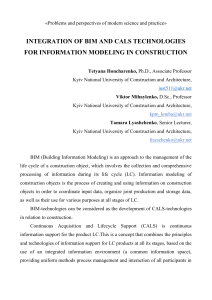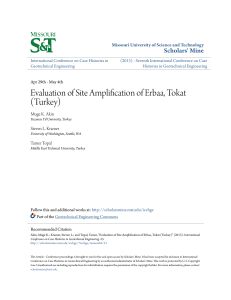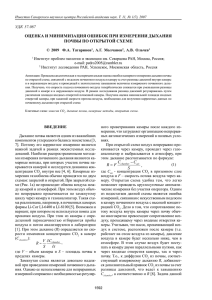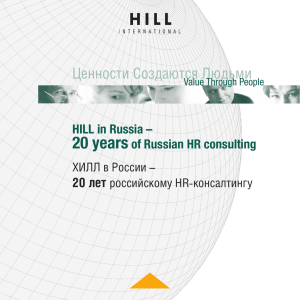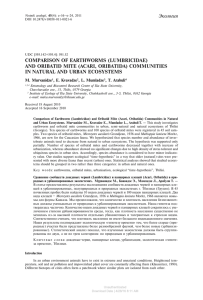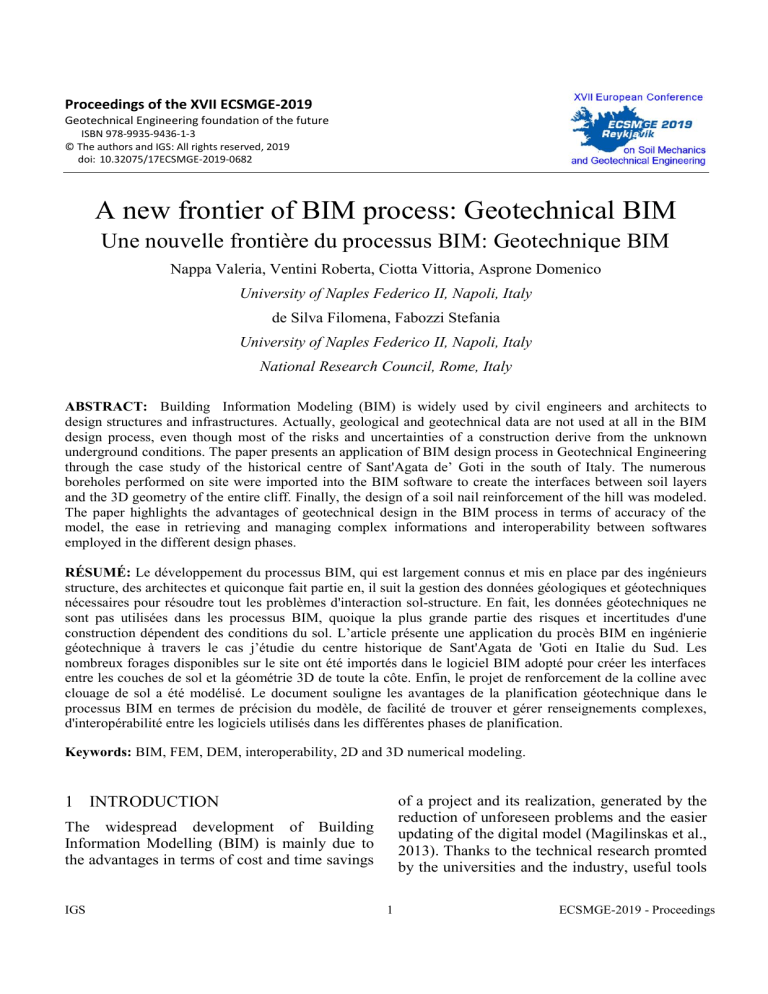
Proceedings of the XVII ECSMGE-2019 Geotechnical Engineering foundation of the future ISBN 978-9935-9436-1-3 © The authors and IGS: All rights reserved, 2019 doi: 10.32075/17ECSMGE-2019-0682 A new frontier of BIM process: Geotechnical BIM Une nouvelle frontière du processus BIM: Geotechnique BIM Nappa Valeria, Ventini Roberta, Ciotta Vittoria, Asprone Domenico University of Naples Federico II, Napoli, Italy de Silva Filomena, Fabozzi Stefania University of Naples Federico II, Napoli, Italy National Research Council, Rome, Italy ABSTRACT: Building Information Modeling (BIM) is widely used by civil engineers and architects to design structures and infrastructures. Actually, geological and geotechnical data are not used at all in the BIM design process, even though most of the risks and uncertainties of a construction derive from the unknown underground conditions. The paper presents an application of BIM design process in Geotechnical Engineering through the case study of the historical centre of Sant'Agata de’ Goti in the south of Italy. The numerous boreholes performed on site were imported into the BIM software to create the interfaces between soil layers and the 3D geometry of the entire cliff. Finally, the design of a soil nail reinforcement of the hill was modeled. The paper highlights the advantages of geotechnical design in the BIM process in terms of accuracy of the model, the ease in retrieving and managing complex informations and interoperability between softwares employed in the different design phases. RÉSUMÉ: Le développement du processus BIM, qui est largement connus et mis en place par des ingénieurs structure, des architectes et quiconque fait partie en, il suit la gestion des données géologiques et géotechniques nécessaires pour résoudre tout les problèmes d'interaction sol-structure. En fait, les données géotechniques ne sont pas utilisées dans les processus BIM, quoique la plus grande partie des risques et incertitudes d'une construction dépendent des conditions du sol. L’article présente une application du procès BIM en ingénierie géotechnique à travers le cas j’étudie du centre historique de Sant'Agata de 'Goti en Italie du Sud. Les nombreux forages disponibles sur le site ont été importés dans le logiciel BIM adopté pour créer les interfaces entre les couches de sol et la géométrie 3D de toute la côte. Enfin, le projet de renforcement de la colline avec clouage de sol a été modélisé. Le document souligne les avantages de la planification géotechnique dans le processus BIM en termes de précision du modèle, de facilité de trouver et gérer renseignements complexes, d'interopérabilité entre les logiciels utilisés dans les différentes phases de planification. Keywords: BIM, FEM, DEM, interoperability, 2D and 3D numerical modeling. of a project and its realization, generated by the reduction of unforeseen problems and the easier updating of the digital model (Magilinskas et al., 2013). Thanks to the technical research promted by the universities and the industry, useful tools 1 INTRODUCTION The widespread development of Building Information Modelling (BIM) is mainly due to the advantages in terms of cost and time savings IGS 1 ECSMGE-2019 - Proceedings F.2. Developments and innovations in geotechnical engineering, education and practice have been developed to optimize digital models and improve interoperability between the different skills involved in the design process. At the same time, slower advances have been observed in the last years in the application of the BIM process in the geotechnical field, although many civil engineering problems derive from unknown soil conditions. Not many examples of geotechnical constructions have been designed by adopting a BIM-based approach and, in the most cases, it consisted in file, store and update gological and geotechnical data only (Morin et al., 2014; Tawelian et al., 2016; Svenson et al., 2017; Zang et al., 2018). Certainly, the data sharing is the core of BIM approach, but more aspects can be exploited in the geotechnical field. The paper demonstrates the applicability of the BIM approach to the whole design process of a soil nailing intervention to stabilize a side of the Sant'Agata de’ Goti hill in the south of Italy. The advantages to model the complex geometry of the hill and its layered soil, as well as the interoperability with 2D and 3D adopted numerical softwares, are highlighted. explosive episode of the Campi Flegrei. Two typical lithofacies of the formation (Cappelletti et al., 2003) have been recognized, i.e. an uppermost well-cemented tuff (Lithified Yellow Tuff, LYT) and an underlying lightly welded deposit of grey ash (Welded Grey Ignimbrite, WGI). The whole rock slab overlies a Miocene flysch formation (MF), constituted by arenaceous-clayey sediments. A mélange of made ground and pyroclastic soil (MG-PS) covers the hill. A deeper description of the subsoil investigations is reported in de Silva et al. (2013) and Scotto di Santolo et al. (2015). Basing on the contour lines of the ground level and on the borehole logs, the geological sections shown in Figure 2 were realized. Borehole N B B A A 2 CASE OF STUDY Figure 1. Location of the boreholes on the aerial view of Sant‘Agata de‘ Goti hill. The historical centre of Sant’Agata de’Goti, in the south of Italy, was settled during the preRoman period on the top of a hill surrounded by two rivers, Riello and Martorano. This strategic location, that was chosen to prevent enemy invasions, increased its vulnerability to landslides and seismic risk, as occurred for other small towns located on soft rock slabs or stiff soil ridges of Central-Southern Italy (Fenelli et al., 1998). The subsoil was widely investigated in 1994, when 40 boreholes were drilled down to 40 m. The location of the performed boreholes is superimposed on the aerial view of the town in Figure 1. The main formation of the ridge is the Campanian Ignimbrite, a volcanoclastic soft rock generated about 39,000 yrs BC (De Vivo et al., 2001), during the ECSMGE-2019 – Proceedings The digital soil model of the hill described below accurately reproduces the variability of its shape and the irregular interface between the soil layers. 3 BIM-BASED PROJECT A procedure to implement the geological and geotechnical informations into a BIM model of the hill was adopted with the following BIMwork-flow consisting of four main phases: 2 IGS A new frontier of BIM process: Geotechnical BIM - Phase 1: Definition of the surface topography, geological and geotechnical data-management for the definition of the BIM-hill-model; - Phase 2: Definition of the numerical hill model; - Phase 3: Analysis of the hill stability and design of soil reinforcement; - Phase 4: BIM-based design of soil reinforcement. 3.1 Digital model of the hill (Phase 1) The Phase 1 of the BIM-work-flow (§3) allowed to define the digital model of the hill of Sant'Agata de’ Goti ensuring a more effecient design process and greater control than the traditional design approach. Starting from the three-dimensional cartographical base defined in a preliminary design phase through InfraWorks360 (Autodesk software house), the available georeferenced boreholes were imported in Civil 3D to define the hill stratigraphy (Figure 3a). All surfaces between soil layers were generated by interpolating boreholes data with TIN-interpolating-surfaces, a method often used to create 3D models over soil layers (Figure 3b). The informations gathered in the model concerns geographical location, geometry, stratigraphy and geotechnical properties of each soil layer. Section AA Section BB 0 Made ground and pyroclastic soil (mg-Ps) Lithified Yellow Tuff (LYT) Welded Grey Ignimbrite (WGI) Miocene flysch formation Figure 2. Geological sections located in Figure 1 resulting from the interpretation of the boreholes. The first phase of the adopted BIM-workflow was managed with the BIM authoring software Autodesk Civil 3D, exploiting the capabilities of the geotechnical module, i.e. a tool dedicated to geotechnical aspects made available by the software. In Phase 2, the geometry of the soil layers were imported in Plaxis 3D and Flac 3D, to define the numerical model of the hill. Furthermore, two-dimensional hill sections were extrapolated from the 3D BIM model to perform 2D stability analyses for the design of the soil reinforcement. Once the 3D digital model of the hill was defined in Phase 1, the BIM model was completed in Phase 4, by integrating soil reinforcements. This latter was defined in Revit, a BIM software dedicated to structures. IGS Figure 3. Digital model of Sant‘Agata de‘ Goti hill: (a) hill stratigraphy; (b) 3D hill BIM model. The main advantages of the soil model generated into a BIM tool are the followings: 1) to manage and update soil data during the entire site investigation process; 2) the results of site and laboratory tests are shared in a common data environment to properly calibrate the geotechnical model for the spe3 ECSMGE-2019 - Proceedings F.2. Developments and innovations in geotechnical engineering, education and practice cific problem that in turn re-enter in the BIM flow; 3) possibile generation of 2D stratigraphic profiles, calculation of volumes and finally exportation of results into other interoperable BIM platforms. Starting from the numerical results obtained in terms of vertical displacements due to the gravity loading in Plaxis (Figure 5a) and Flac 3D (Figure 5b), a two-dimensional section has been extrapolated from the BIM model of the hill implemented in Civil 3D to perform stability analysis and design the soil reinforcement. Figure 6 shows as an example a section of the hill for which the stability analysis was performed, followed by the design of the soil reinforcement. 3.2 Numerical model of hill (Phases 2- 3) Phase 2 of the BIM-work-flow (§3) consists of importing the hill model into numerical software, Plaxis 3D (Reference Manual, 2018) and Flac 3D (Itasca, 2015) for instance, to perform numerical analyses of the hill stability. Since FEM and DEM codes such as Plaxis and Flac respectively do not yet support notproprietary formats, currently BIM-FEM/BIMDEM interoperability consists of an exchange of geometric information. In fact in this case study the geometry of (1) the ground topography, (2) the stratigraphy and (3) the soil reinforcement; were imported as geometric entities, i.e. surfaces and lines. Once the model geometry has been imported, the following meshing phase converts the model into a numerical mesh. Figure 4 shows the mesh of the hill model generated by the both used numerical codes. Figure 5. Vertical displacements due to gravity loading calculated in (a) Plaxis 3D and (b) Flac 3D. Figure 6. Numerical mesh of the hill section considered for the stability analysis and the design of the soil nailing (Plaxis 2D). Figure 4 . Numerical model of Sant‘Agata de‘ Goti hill carried out in (a) Plaxis 3D and (b) Flac 3D. ECSMGE-2019 – Proceedings 4 IGS A new frontier of BIM process: Geotechnical BIM A specific family object was created in Revit for both the steel soil-nail and its concrete anchor. The geometric dimensions, that are the length, the diameter and the inclination of the element and the material type were considered as digitalized parameters of the steel soil nail and its anchor. The digitalized concrete anchor required at the bottom side of the steel soil-nail is shown in Figure 8. 3.3 BIM design of soil reinforcement (Phases 4) The project of the reinforcement intervention was implemented in the BIM-work-flow in order to estimate quantities and costs. The above-mentioned intervention consists of seventy-two steel soil-nails and an electrowelded mesh as shown in Figure 7a,b. The related BIM process consists of the following steps: 1) the BIM hill model defined in Civil 3D was imported in Revit Autodesk software (Figure 7a); 2) two specific BIM-objects were created to represent the steel soil-nail and its concrete anchor (see Figure 8); 3) the BIMobjects were placed in the model with their designed inclination and spacing (Figure 7b); 4) the electro-welded mesh was modelled to perfectly fit the hill model. Figure 8. Digitalized concrete anchor of the steel soil-nail in the BIM environment: a) Revit family parametrization; b) digitalized parameters. 3.3.1 Once the objects were defined, it was possible to model the design intervention. Thus, quantities were determined by using Revit ‘schedules’, which are automatically extracted from the BIM model. Figure 7. BIM model of the Sant’Agata de’ Goti hill modelled in Revit Autodesk: a) 3D model with the steel soil-nails and the electro-welded mesh; b) 2D section considered for the stabilization intervention. IGS Quantity and cost estimation 5 ECSMGE-2019 - Proceedings F.2. Developments and innovations in geotechnical engineering, education and practice Revit charts allow to highlight the most interesting parameters depending on the purpose. Accordingly, two charts were defined to allow material amount and cost estimations (see for example Figure 9 for the quantities): the ‘chart of soil-nails’ (Figure 9a) provides the counting of the steel nails and the concrete anchors required by the intervention as well as the volume of the elements; the ‘chart of nets’ (Figure 9b) provides the area of the electrowelded mesh in square meters. aspects seem to neglect them in the BIM approach. The present work is carried out to verify the current status of the geotechnical project in BIM and then to understand how to improve this process. To achieve this goal, an application of the BIM process in Geotechnical Engineering was defined through the case study of the historical centre of Sant'Agata de’ Goti, in the southern Italy. The original project of reinforcement interventions was reproduced in BIM environment highlighting pro and cons of this innovative process. The numerous boreholes available on site were imported into the adopted BIM software to create the interface surfaces between soil layers and the 3D geometry of the entire cliff. Finally, the reinforcement design of the hill with soil nailing was modeled. Once the objects were defined, the quantities were carefully determined. As a result, two charts were defined to allow estimation of material quantities and costs. The paper highlights the advantages of geotechnical design in the BIM process in terms of model accuracy, the ease in retrieving and managing complex informations and interoperability between the software used for the various phases of design. (a) (b) Figure 9. Revit quantity charts for (a) soil nails and (b) electro-welded mesh. Table 1. Material volumes and cost estimations. Revit charts can be extracted and opened as ‘.xls’ files to assess the amount of materials such as: steel, concrete and electro-welded mesh. Table 1 shows the total quantities and costs of the mentioned materials and, eventually, the cost of the entire intervention. 4 CONCLUSIONS Material Volume Mass [kg] 3058,6 Cost each [€/m3] 1,94 Cost Total [€] 5933,6 Steel [m ] 0,42 Concrete 2,65 - 125,1 331,5 Material Surface Cost each [€/m2] 1,53 Cost Total [€] 1848,2 E. w. mesh [m2] 1208 8113,3 The Building Information Modeling (BIM) is becoming an important design approach in civil engineering for infrastructure, construction, operational and process management. Very often, many structures and infrastructures projects that have significant geotechnical ECSMGE-2019 – Proceedings 6 IGS A new frontier of BIM process: Geotechnical BIM Itasca Consulting Group Inc. 2015 - FLAC3D Fast Lagrangian Analysis of Continua Version 5.01. Minneapolis, MN. Migilinskas D., Popov V., Juocevicius V., Ustinovichius L., 2013. The Benefits, Obstacles and Problems of Practical Bim Implementation. Procedia Engineering, 57, 767-774. Morin G., Hassall S., Chandler R. 2014. Case study - The real life benefits of Geotechnical Building Information Modelling. Proceedings of Information Technology in Geo-Engineering. D.G. Toll et al. (Eds.), 95102. Plaxis 2D Reference Manual 2017. Plaxis 3D Reference Manual 2018. Svensson M., Friberg O., 2017. GeoBIM - a tool for optimal geotechnical design. Proceedings of the 19th International Conference on Soil Mechanics and Geotechnical Engineering, Seoul. 17811784. Scotto di Santolo, A., de Silva, F., Calcaterra, D., Silvestri, F. 2015. Preservation of cultural heritage of S. Agata de’ Goti (Italy) from natural hazards. Engineering Geology for society and territory. Volume 8, Preservation of Cultural Heritage, 421-425 Springer International Publishing, Switzerland. Tawelian L.R., Mickovski S.B. 2016. The Implementation of Geotechnical Data Into the BIM Process. Proceedings of the 3rd International Conference on Transportation Geotechnics, 143, 734-741. Zhang, J., Wu, C., Wang, Y. et al. 2018. The BIM-enabled geotechnical information management of a construction project. Computing, 100, 47-63. 5 ACKNOWLEDGEMENTS The study was carried out in the frame of the Future Environmental Design (FED) spinoff of Federico II University of Naples. 6 REFERENCES Autodesk, 2017. AutoCAD Civil 3D 2018 – User’s Guide. Autodesk Inc. San Rafael, USA. Autodesk, 2017. Revit Architecture 2018 – User’s Guide. Autodesk Inc. San Rafael, USA Cappelletti, P., Cerri, G., Colella, A., de’ Gennaro, M., Langella, A., Perrotta, A., Scarpati, C. 2003. Post-eruptive processes in the Campanian Ignimbrite. Mineralogy and Petrology 79: 79-97. de Silva F., Melillo M., Calcaterra D., Fascia F., Scotto di Santolo A., Silvestri F., Stendardo L., (2013). A study for the requalification and safety against natural hazards of the environmental and building heritage of Sant’Agata de’ Goti (Italy). Geotechnical Engineering for the Preservation of Monuments and Historic Sites, 307-316, Taylor & Francis Group, London. De Vivo, B., Rolandi, G., Gans, P.B., Calvert, A,. Bohrson, W.A., Spera, F.J., Belkin, H.E. 2001. New constraints on the pyroclastic eruptive history of the Campanian volcanic Plain (Italy). Mineralogy and Petrology 73: 47-65. Fenelli, G.B., Pellegrino, A. & Picarelli, L. 1998. Stability problems of old towns built o relict plateaux on clay deposits. In C. Viggiani (ed.), Proc. Int. Symp. on Geotechnical engineering for the preservation of monuments and historical sites, Napoli, 163-173. Rotterdam: Balkema. ITASCA, 2011. FLAC – Fast Lagrangian Analysis of Continua – Versione 7.0. Manuale Utente, Itasca Consulting Group, Minneapolis, USA. IGS 7 ECSMGE-2019 - Proceedings
